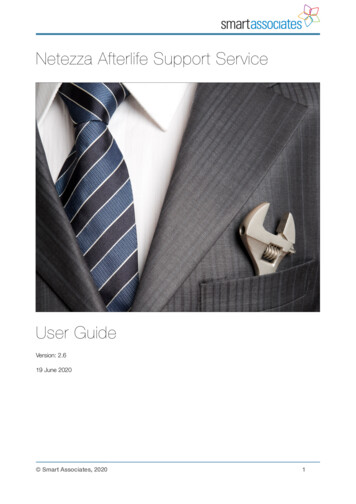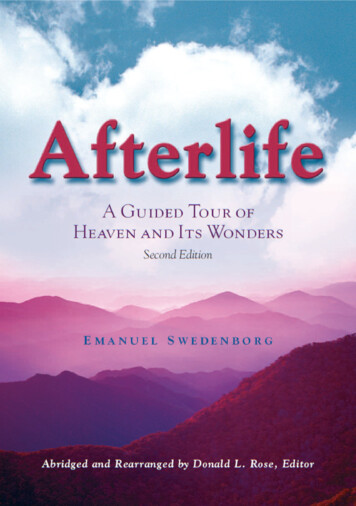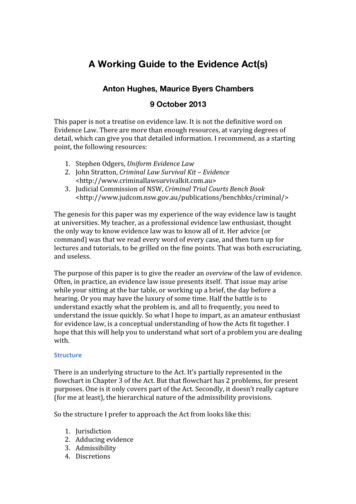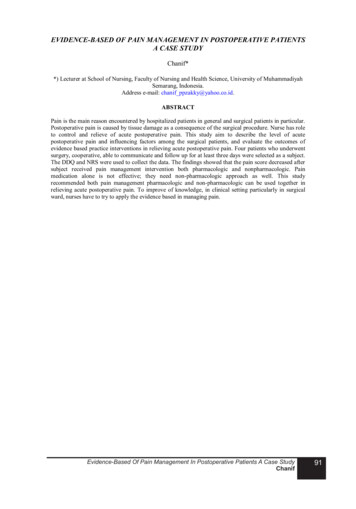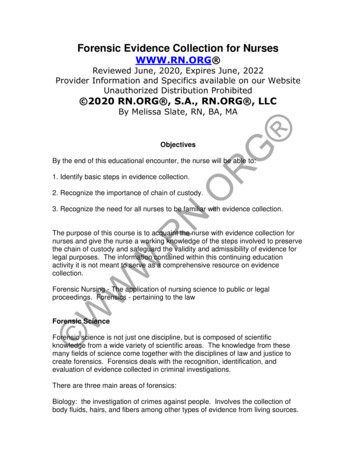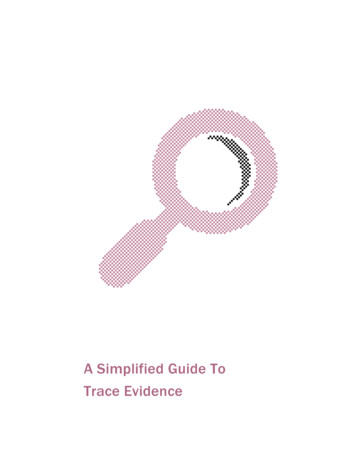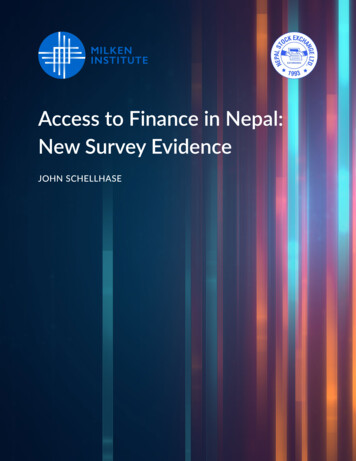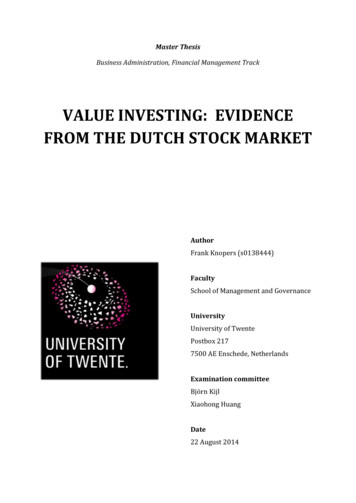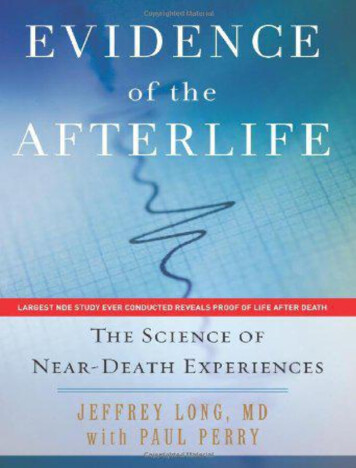
Transcription
Evidence of the AfterlifeThe Science of Near-Death ExperiencesJeffrey Long, MDwith Paul Perry
DEDICATED TO THE THOUSANDS OF PEOPLE WHO HAVE SHARED THEIREXCEPTIONAL EXPERIENCES WITH US OVER THE YEARS, AND TO THOSEWHO WILL SHARE IN THE FUTURE. YOU ARE AMONG THE GREATEST OFTEACHERS.DEDICATED TO NEAR-DEATH-EXPERIENCE RESEARCHERS,PAST AND FUTURE.DEDICATED TO JODY LONG, WHOSE EFFORTS MADE THIS BOOKPOSSIBLE.
ContentsIntroduction1. First Encounters2. Journey Toward Understanding3. Proof #1: Lucid Death4. Proof #2: Out of Body5. Proof #3: Blind Sight6. Proof #4: Impossibly Conscious7. Proof #5: Perfect Playback8. Proof #6: Family Reunion9. Proof #7: From The Mouths of Babes10. Proof #8: Worldwide Consistency11. Proof #9: Changed LivesConclusionNotesAbout the Author
CreditsCopyrightAbout the Publisher
IntroductionA bit beyond perception’s reachI sometimes believe I seethat Life is two locked boxes, eachcontaining the other’s key.—Piet HeinIt was 1984 when I first stumbled upon the phrasenear-death experience (NDE) in the pages of amedical journal. It was several years later that I heard afriend’s wife tell of her own NDE when she nearly diedof an allergic reaction while under general anesthetic.More than ten years later, in 1998, I started the NearDeath Experience Research Foundation and itscorresponding website, NDERF.org.One of my goals for the site was to collect asmany NDEs as I could and to collect them through aquestionnaire that would make it easy to separate andstudy their elements. With such a questionnaire, I couldexamine the individual elements in NDEs or an entireNDE itself. I expected to be successful in an endeavor,but as it has turned out, I have been wildly successful.Over the course of the first ten years, more than 1,300people who had a near-death experience spent manyhours of their precious time answering over onehundred questions in NDERF’s detailed questionnaire.These people are of every race, creed, and color and
are from virtually every corner of the world.That so many people are willing to share theirNDEs with others speaks volumes about the power ofthese experiences in a person’s life. Respondentsdescribe their experiences in a variety of ways, callingthem “unspeakable,” “ineffable,” “unforgettable,”“beautiful beyond words,” and so on. More than 95percent of the respondents feel their NDE was“definitely real,” while virtually all of the remainingrespondents feel it was “probably real.” Not onerespondent has said it was “definitely not real.” Somesay it was not only the most real thing to ever happento them but also the best event of their lives. As onerespondent who nearly died in a suicide attempt wrote:I was at peace with myself. Nothing hurt. I could onlysee my life and self through that Being’s Love. Therewas no negative in myself or from that Being foranything I had done, including killing myself. It [mydeed] was changed by the power of the Truth of Love,with which it was seen. That Loving Grace, totalacceptance, complete love and truth created a joy inme. I saw that love was in me too, not just from theBeing shining down on me; it was in me as part ofmyself. I was full of love and peace. I felt the joy inthat truth. I have no right words for it.I have seen this type of response from manypeople with near-death experiences. Imagine that—anexperience that begins with the sheer terror of a lifethreatening event and evolves into an event of wonderand mystery!I am a man of science, and as a result I haveexamined the data from the NDERF study in a
scientific way. At NDERF we explored all of theelements in the NDEs of more than one thousandpeople, examining consistency among the accounts. Inreaching conclusions about these accounts, wefollowed a basic scientific principle: What is real isconsistently seenobservations.amongmanydifferentThe results of the NDERF study clearly indicateremarkable consistency among NDE case studies.This study finds that what people discovered duringtheir near-death experience about God, love, afterlife,reason for our earthly existence, earthly hardships,forgiveness, and many other concepts is strikinglyconsistent across cultures, races, and creeds. Also,these discoveries are generally not what would havebeen expected from preexisting societal beliefs,religious teachings, or any other source of earthlyknowledge.In a world that is plagued by afflictions of the soul,this is very good news. Many of the personal andsocial problems that face humanity—drug and alcoholabuse, depression, anxiety, gang violence, religiousstrife, racism, and so on—could be greatly affected bysuch a powerful common experience. Because NDEshappen to people all over the world, they are a spiritualthread that binds us together, a common experiencethat reminds us of our mutual spiritual nature. At itsvery least, the NDERF study contributes informationthat strengthens our understanding of that spiritualthread.But the NDERF study is also exceptionallyvaluable in the way that it brings us closer tounderstanding what happens when we die. I long agoquit believing that death is the cessation of our
existence. It took me a long time to reach this point. Iwas born into a scientific family. My father was thechair of the Department of Pharmacology at theUniversity of Iowa and a onetime contender for theNobel Prize. Through him and others in our family Ideveloped great respect for science.By scientifically studying the more than 1,300cases shared with NDERF, I believe that the nine linesof evidence presented in this book all converge on onecentral point: There is life after death.The convergence of several lines of evidence—like the nine presented in this book—builds a muchstronger case than only a single line of evidence.For example, suppose we had only two lines ofNDE evidence. We may not be 100 percent convincedthat these two lines of evidence prove an afterlife, butperhaps each line of evidence by itself is 90 percentconvincing. Combined, these two lines of evidence bymathematical calculation are 99 percent convincingthat the afterlife exists.1Given how complex it is to mathematically analyzeonly two lines of evidence, imagine how mind-bogglingit would be to mathematically analyze all nine lines ofNDE evidence. Fortunately, that won’t be necessary.The NDERF website includes a custom-designed formthat automatically performs these mathematicalcalculations. This website wizardry allows you tocalculate for yourself how strongly you believe the ninelines of evidence prove the existence of an afterlife.You can also see the results obtained from every otherperson who has completed this form. This form, andother material supplementing this book, is available onthe NDERF website at our page that exploresevidence of the afterlife (http://www.nderf.org/afterlife).
The form addresses concepts presented throughoutthis book. Thus I would encourage you to finish readingthis book before you complete the form.WHAT HAPPENS DURING A NEAR-DEATHEXPERIENCEBefore continuing, I should provide a detailedexplanation of what a near-death experience is.Near-death experiences (NDEs) are events thattake place as a person is dying or, indeed, is alreadyclinically dead. People who have NDEs are callednear-death experiencers (NDErs). From the time neardeath experiences were first medically researchedand described by Dr. Raymond Moody in hispioneering book, Life After Life, in 1975, medicaldoctors and other researchers have examined thisphenomenon in depth.2There is no widely accepted definition of neardeath experience. The NDERF study took astraightforward approach by defining both the neardeath and experience components of near-deathexperience. I considered individuals to be “near death”if they were so physically compromised that they woulddie if their condition did not improve. The NDErsstudied were generally unconscious and oftenapparently clinically dead, with absence of heartbeatand breathing. The “experience” had to occur at thetime they were near death. Also, the experience had tobe lucid, to exclude descriptions of only fragmentaryand disorganized memories.Throughout this book we will present the results ofthe NDERF survey. Unless otherwise indicated, these
will be the results from surveying 613 sequentialNDErs who completed the most recent version of theNDERF survey. 3 This version of the survey includedthe NDE Scale questions.4 The NDE Scale askssixteen questions about the content of the experienceand is the most validated research method to helpdistinguish experiences that are near-deathexperiences from those that are not. The 613 NDErswhose survey results we are presenting here all hadNDE Scale scores of 7 or above, further validatingthese experiences as actual NDEs. The originalversion of the NDERF survey studied responses from413 NDErs. The NDE Scale questions were not usedin the original NDERF survey.No two near-death experiences are identical.However, when many near-death experiences arestudied, a pattern of elements that commonly occurs inNDEs is easily seen. These elements usually occur inconsistent order.Researchers have concluded that NDEs mayinclude some or all of the following twelve5 elements:61. Out-of-body experience (OBE): Separation ofconsciousness from the physical body2. Heightened senses3. Intense and generally positive emotions or feelings4. Passing into or through a tunnel5. Encountering a mystical or brilliant light6. Encountering other beings, either mystical beingsor deceased relatives or friends7. A sense of alteration of time or space8. Life review9. Encountering unworldly (“heavenly”) realms
10. Encountering or learning special knowledge11. Encountering a boundary or barrier12. A return to the body, either voluntary or involuntaryBelow are descriptions of each of these elementsfrom the case studies I have amassed over more thanten years of research, as well as the percentage ofNDErs from our study group who experienced each ofthe elements.1. Out-of-Body Experience (OBE)I could feel my spirit actually leaving my body. I sawand heard the conversations between my husbandand the doctors taking place outside my room, aboutforty feet away down a hallway. I was later able toverify this conversation to my shocked husband.One NDEr observed in the out-of-body state thereaction of the doctor to nearly losing this patient:Why were you so upset, screaming and swearing inthe operating room? Didn’t you know that I could hearevery word you said?This NDEr then shared what the doctor responded:You are right. I was so frustrated and tired and angryin that operating room that I just started screamingwhen we were losing you. It was either scream or cry.You were dying, and there was not a damned thingthat I could do to stop it. I will have to rethink what Isay to an unconscious patient from now on, won’t I?
Out-of-body experiences are often the first NDEelement. The NDERF survey asked 613 NDErs, “Didyou experience a separation of your consciousnessfrom your body?”In response, 75.4 percent answered “Yes.”2. Heightened SensesThere isn’t a way to explain it, as there is no feelinglike it here on earth. It was crystal clear. It was likegoing home at last, at last. A feeling of belonging, ofmeaning, of completeness.It just seemed so much more real than anything I hadever experienced in my entire life.The NDERF survey asked, “How did your highestlevel of consciousness and alertness during theexperience compare to your normal, everydayconsciousness and alertness?” Of the NDErssurveyed, 74.4 percent indicated they had “Moreconsciousness and alertness than normal.”3. Intense and Generally Positive Emotions orFeelingsThis is the hardest thing to try and explain . Wordswill not come close to capturing the feelings, but I’lltry: total, unconditional, all-encompassing love,compassion, peace, warmth, safety, belonging,understanding, overwhelming sense of being home,
and joy.All I felt was love, joy, happiness, and every wonderfulemotion you could feel all at once.Total peace, total calm. I was not in the least bit afraidor anxious.When we got to the light, the totality of life was loveand happiness. There was nothing else. And it wasintense. Very intense and endless in scope.[I felt an e]xtreme sense of love and peace andbeauty that I cannot describe in words.The NDERF survey asked, “Did you have afeeling of peace or pleasantness?” To this question,76.2 percent selected “Incredible peace orpleasantness.” The NDERF survey asked anotherquestion about a specific emotion during the NDE:“Did you have a feeling of joy?” NDErs responded tothis question with 52.5 percent selecting “Incrediblejoy.”A small percentage of NDEs are frightening to theNDEr. This topic is addressed in detail on the NDERFwebsite.74. Passing Into or Through a TunnelMy next awareness was of being submerged andcradled in a warm, wavy, wafting motion at theopening of a tunnel. The tunnel had billowy soft sidesand was well lit, with the tunnel dimensions
decreasing and brightness increasing as it got closerto a single bright light.We traveled very fast into a tunnel. The tunnel was alldifferent colors: blue, yellow, white, green, and red.The NDERF survey asked, “Did you pass into orthrough a tunnel or enclosure?” Of NDErs respondingto this survey question, 33.8 percent answered “Yes.”5. Encountering a Mystical or Brilliant LightA brilliant white light at the end of the tunnel, andwhen the wings enveloped me I became part of thewhite light.A beautiful light drew me to itself; the light stilltouches me with awe, and tears come immediately.At first the light was blue. Then it transitioned to white.It was an opalescent white; it almost glowed, but didnot shine. It was bright, but not intense bright, likeglowing bright—pure bright. Pure but not in the usualsense of the word. Pure as in something you’ve neverseen before or could ever describe or put into words.It was as if we passed through a wall into my light poddirectly. There was a large majestic center light andthen the individual yet connected pod lights exactlylike the center light only smaller. I think now the podlights, like mine, were other souls connected to thecenter light, God.
The light may be described as brilliant, “like amillion suns,” but virtually never hurts the NDEr to lookat it. NDErs may dramatically describe their strongattraction to the light and their emphatic desire toapproach or merge with the light. The NDERF surveyasked, “Did you see a light?” NDErs responded with64.6 percent answering “Yes.”6. Encountering Other Beings, Either Mystical Beingsor Deceased Relatives or FriendsI was surrounded by other beings, or people, who I feltas though I recognized. These beings were likefamily, old friends, who’d been with me for an eternity.I can best describe them as my spiritual or soulfamily. Meeting these beings was like reuniting withthe most important people in one’s life, after a longseparation. There was an explosion of love and joyon seeing each other again between us all.My dad was right next to me, but I couldn’t see himvisually. My sister was very close; I felt she was to myleft. I felt other family members close by, but I did notsee them. My sister and other family membersseemed to be more to the left. The only personbesides my sister and my dad that I knew was therewas my grandmother. There were others there butnone I can say for certain besides the ones Imentioned.I heard my mother’s and daughter’s voices, but mydaughter, who was only approximately two at the time,
well, it was the sound of her voice grown up, but I knewit was her voice. They called my name, and my bodymoved like through an air current very quickly. It waslike the wind carried me so fast, and I saw a bright,bright light very quickly and then a beach, and then Isaw my mom and daughter standing on the beach;my daughter was grown up.The NDERF survey asked, “Did you meet or seeany other beings?” In response, 57.3 percentanswered “Yes.” When NDErs encounter deceasedbeings, most are deceased relatives as opposed tofriends or loved ones. Some NDErs encounterseemingly familiar beings, but they cannot recallhaving previously met them. Later in their lives someNDErs recognize a picture of a deceased relative asthe being they encountered in their NDE. The relativemay have died years or even decades before theNDEr was born.7. A Sense of Alteration of Time or SpaceWhen I first left my body I had my diving watch on. Itook some very unscientific measurements of thedistance I traveled by watching for features andmeasuring them by the second hand on my watch.Totally unscientific. But my conclusion was and hasalways been: I was measuring time in an altered time.The ground never moved in a linear fashion; thedistances were erratic at best. The distances werealways changing, sometime[s] repeating and theninstantly becom[ing] longer or short[er] than theprevious distance. Yet my watch was always ticking
without change. My intuition and impression were thatI was in a different time zone, one where my earth[l]ywatch was of no use or inept at making anymeasurement or reflecting time. Also without mistakeI would say this whole thing took an hour or more. Itseemed to me that I was in the NDE for a very longtime. But when I asked my diving partners how longhad I been unconscious, they estimated five to tenminutes. Thus I had another reason to support whymy diving watch didn’t seem to measure the time inmy NDE.It seemed as though I experienced so much in sucha small length of earthly time. Where my soul hadtraveled to know nothing of time as we know [of] timepassing on earth.Both time and space in earth stopped completely.Simultaneously, “the time and the space” on theother side was completely alive, evident[ial], and real.Yes, while I was in the light, I had [no] sense of timeas I know it here on Earth. In other words, no sense ofthe serial nature of time past, present, or future. Alltimes (past, present, and future) were experienced atevery moment in time while I was in the light.The NDERF survey asked, “Did you have anysense of altered space or time?” To this question themajority, 60.5 percent, answered “Yes.” AnotherNDERF survey question focused only on an alteredsense of time, asking, “Did time seem to speed up?”NDErs responded to this question with 33.9 percent
selecting “Everything seemed to be happening all atonce.”8. Life ReviewI saw my life flash before me shortly after I left mybody and was still in the hospital room. I was told thatI was going to help educate and teach many people,and that is exactly what I am doing now.I saw every important event that had ever happenedin my life, from my first birthday to my first kiss tofights with my parents. I saw how selfish I was and howI would give anything to go back and change.Next he showed me my life review. Every secondfrom birth until death you will see and feel, and [youwill] experience your emotions and others that youhurt, and feel their pain and emotions. What this is foris so you can see what kind of person you were andhow you treated others from another vantage point,and you will be harder on yourself than anyone tojudge you.I will not see what others have done to you. I will seewhat you have done to others.Life reviews involve a review of prior events of theNDEr’s life. Fragments of one’s earthly life may beseen, or the review may be panoramic, covering all ofone’s earthly life. The NDERF survey asked, “Did youexperience a review of past events in your life?” Tothat question, 22.2 percent of NDErs answered “Yes.”
9. Encountering Unworldly (“Heavenly”) RealmsWell, the end of that tunnel was the most peacefulplace; it was beyond my imaginings, pure, serene,and loving.The landscape was beautiful, blue skies, rolling hills,flowers. All was full of light, as if lit from within itselfand emitting light, not reflecting it.There was such beauty, beautiful beyond expression.There was also a bright city or something like a city inthe distance. The colors and structures of everything[were] beautiful awesome.All around me I could see and feel a beautiful peaceand tranquillity with love and peace . As far as theeye could see to my left was a beautiful landscape oftulips of every color imaginable. To my right was awall of a beautiful blue that matched the sky.The sound of that music I cannot possiblydescribe with words because it simply cannot beheard with that clarity in this world! The colors wereout of this world—so deep, so luminous, so beautiful!The NDERF survey asked, “Did you see or visitany beautiful or otherwise distinctive locations, levels,or dimensions?” To this question 40.6 percent ofNDErs chose “Yes.”Asking this question in a more general way, the
NDERF survey asked, “Did you seem to enter someother, unearthly world?” To this question 52.2 percentof NDErs responded that they encountered anunearthly realm.10. Encountering or Learning Special KnowledgeWhen I looked into his eyes all the secrets of theuniverse were revealed to me. I know how everythingworks because I looked into his eyes for a moment.All the secrets of the universe, all knowledge of alltime, everything.I understood (I use this term because I did notactually hear) the colored drops were the experiencesof all who had lived. The experiences existed asseparate items yet belonged to the whole. The wholewas the collective knowledge of all.The NDERF survey asked, “Did you have a senseof knowing special knowledge, universal order, and/orpurpose?” To this question 56.0 percent of NDErsanswered “Yes.” Another question asked, “Did yousuddenly seem to understand everything?” To thisquestion, 31.5 percent responded that they seemed tounderstand everything “About the universe,” and 31.3percent responded that they seemed to understandeverything “About myself or others.”11. Encountering a Boundary or BarrierOn my side of the boundary, time seemed to go slow.
On the other side, time went by faster.There was this door in front of me with this musiccoming out and people celebrating with utter joy that Iknew and recognize[d] as home. Once [I] crossed, Icouldn’t come back.I reached the point where I felt I had to make thechoice whether to go back to life or onward into death.My best friend was there (who had died of cancer twoyears before), and she told me that this was as far as Icould go or I would not be able to turn back. “Youhave come to the edge. This is as far as you can go,”she said. “Now go back and live your life fully andfearlessly.”I wasn’t allowed to cross that boundary. There was nochoice.The NDERF survey asked, “Did you reach aboundary or limiting physical structure?” To thisquestion 31.0 percent of NDErs answered “Yes.”12. A Return to the Body, Either Voluntary orInvoluntaryI remember as I looked down at them, I said to theangel, “Why don’t they just let her die?” I did notrealize, at that time, the body that I was looking at wasmine. Then in a commanding voice, she [the angel]said, “You must go back now.” “She must live,” shesaid in a soft calming voice. “She has a son to raise.”
I was really hurt that I couldn’t stay because therewasn’t anything that I wanted more than to stay. Purelove is the best way to describe the being and placethat I would be leaving. Under protest, I was sentback.I found out that my purpose now would be to live“heaven on earth” using this new understanding, andalso to share this knowledge with other people.However, I had the choice of whether to come backinto life or go toward death. I was made to understandthat it was not my time, but I always had the choice,and if I chose death, I would not be experiencing a lotof the gifts that the rest of my life still held in store.One of the things I wanted to know was that if I choselife, would I have to come back to this sick body,because my body was very, very sick and the organshad stopped functioning. I was then made tounderstand that if I chose life, my body would healvery quickly. I would see a difference in not months orweeks, but days!The NDERF survey asked, “Were you involved inor aware of a decision regarding your return to thebody?” To this question, 58.5 percent answered “Yes.”EXPERIENCE PROVIDES THE BEST EVIDENCEAs far as I’m concerned, it makes perfect sense thatthe best evidence for understanding what happenswhen we die would come from those who actually didnearly die or even experienced clinical death. This
commonsense perspective is certainly validated in theNDERF study. The substantial majority of people whohad a near-death experience believe their NDEs arereal and are evidence of an afterlife. For NDErs,having a near-death experience is their personal proofof both the reality of the NDE and an afterlife.In science, confirming the reality of a conceptgenerally comes not from a single observation or studybut from many independent studies with differentmethodologies. This cross-checking among scientificstudies has always been the foundation for validatingscientific discoveries. Thus it is vitally important to notethat the NDERF study findings are corroborated byhundreds of prior NDE studies conducted by scores ofNDE researchers. Throughout this book we cite manymajor NDE studies by other researchers. These otherstudies almost always make the same observationsand come to the same conclusions as the NDERFstudy. This adds to the converging lines of evidencethat lead me to conclude: There is life after death.I know this belief takes me out on a limb. Despitea recent poll by the Pew Forum on Religion and PublicLife that shows 74 percent of Americans believe in lifeafter death, I also know that this belief is oftenattributed to people with deep religious conviction.8 Iwant to make it clear that I am both a scientist and abeliever in life after death.I have reconsidered much of what I was taught inmedical school. This reconsideration began manyyears ago, when NDERF had just started. I was in themedical library searching fruitlessly for informationabout near-death experiences. It was unusually quietthat day, and as I sat amid tens of thousands of booksand journals, I easily became lost in my thoughts. At my
fingertips were the greatest medical and scientificstudies and concepts in the world. Yet as I searchedthem, I found that the answer to the mystery of neardeath experiences was not here. In the collectiveknowledge around me from the world’s greatestdoctors and medical scientists, I could find preciouslittle to help me fully understand the near-deathexperience.I left the medical library with the question I hadcome in with: What’s the key to understanding near-death experiences?Later the answer came to me. It was so simple,yet it required a mind-set different from the onecultivated in my academic training. The answer: listen,and listen carefully, to the people who have gonethrough a near-death experience. They surely are oneof the best sources for understanding what awaits usat the brink of death and beyond. Since realizing thatfact, I have never looked back. Near-death studiesfocus on stories and the people who tell them. It isthrough these people and their stories that answers tomany important questions about mortality may befound.
1FIRST ENCOUNTERSA man should look for what is, and not what he thinksshould be.—Albert EinsteinI was in my medical residency at the University of Iowa,looking for a particular article on cancer in the library.The article I was seeking had been published in theJournal of the American Medical Association(JAMA), one of the world’s most prestigious medicaljournals. The journal comes out weekly and is afascinating compilation of medical science andresearch. It is almost impossible for me to pick up anissue and look at only one article, and that is whathappened on this day in 1984 when I sat down withissue number 244.I began thumbing through the journal until Ireached a rebuttal to an article titled “To Sleep,Perchance to Dream,” by Richard Blacher, MD, ofTufts University in Boston. 1 The rebuttal was a letterwritten by Dr. Michael Sabom and was simply titled“The Near-Death Experience.”What’s this “near-death experience”? I thought.Medically speaking, I knew of no conscious
experience that could take place near the point ofdeath. Aren’t people generally unconscious when theyare near death? I wondered. Doesn’t the very termunconscious imply that there is no possibility of anorganized conscious experience?Leaning forward in my chair, I began to read theletter that would change my life.Blacher had rattled Sabom with a comment aboutnear-death experiences, saying that they tell us nothingof the final state of death itself. Blacher went on toinsist that misinterpretation of this experience could beavoided with a closer examination of thisphenomenon, which is what Sabom had recently done.Sabom’s response to Blacher’s article had someelectricity running through it.I have recently conducted a systematic investigation ofthese experiences in 107 persons known to havesurvived an episode of unconsciousness and neardeath (i.e., cardiac arrest and coma). Usingstandardized interview techniques, the social, religiousand demographic backgrounds of each person wereevaluated along with the details of each medical crisisevent and any possible recollections from the period ofunconsciousness . I have had patients describe extensive “out ofbody” experiences during open heart surgery in whichthey observed the operation in distinct “visual” detail.To date, I have been unable to find an adequatemedical explanation for the NDE. Blacher suggeststhat these experiences represent a “fantasy of death”and are manifestations of a hypoxic brain attemptingto deal with “the anxieties provoked by medicalprocedures and talk.” Experimentally, persons
subjected to severe hypoxia have consistently reportedhaving a confused and muddled memory with severeperceptual impairment preceding the loss ofconsciousness. This differs from the clear “visual”perception
of evidence presented in this book all converge on one central point: There is life after death. The convergence of several lines of evidence— like the nine presented in this book—builds a much stronger case than only a single line of evidence. For example, suppose we had only two l
